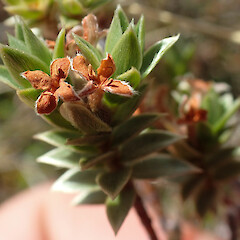Pimelea concinna
Common name
pimelea
Family
Thymelaeaceae
Flora category
Vascular – Native
Endemic taxon
Yes
Endemic genus
No
Endemic family
No
Structural class
Trees & Shrubs - Dicotyledons
NVS code
The National Vegetation Survey (NVS) Databank is a physical archive and electronic databank containing records of over 94,000 vegetation survey plots - including data from over 19,000 permanent plots. NVS maintains a standard set of species code abbreviations that correspond to standard scientific plant names from the Ngä Tipu o Aotearoa - New Zealand Plants database.
PIMCON
Current conservation status
The conservation status of all known New Zealand vascular plant taxa at the rank of species and below were reassessed in 2017 using the New Zealand Threat Classification System (NZTCS) – more information about this can be found on the NZTCS website. This report includes a statistical summary and brief notes on changes since 2012 and replaces all previous NZTCS lists for vascular plants.
Please note, threat classifications are often suggested by authors when publications fall between NZTCS assessment periods – an interim threat classification status has not been assessed by the NZTCS panel.
- Conservation status of New Zealand indigenous vascular plants, 2017 . 2018. Peter J. de Lange, Jeremy R. Rolfe, John W. Barkla, Shannel P. Courtney, Paul D. Champion, Leon R. Perrie, Sarah M. Beadel, Kerry A. Ford, Ilse Breitwieser, Ines Schönberger, Rowan Hindmarsh-Walls, Peter B. Heenan and Kate Ladley. Department of Conservation. Source: NZTCS and licensed by DOC for reuse under the Creative Commons Attribution 4.0 International licence.
2017 | Not Threatened | Qualifiers: DP
Previous conservation statuses
2012 | Not Threatened
2009 | Not Threatened
2004 | Not Threatened
Brief description
Low shrub to 80cm tall with hairy twigs bearing pairs of hairy oval leaves, hairy white flowers and red fruit inhabiting dry valleys around Marlborough. Leaves 5-8mm long by 2.5-5mm wide, broadly pointed.
Distribution
Endemic. South Island: Inland Nelson, Marlborough and North Canterbury (extending just into the Waiau-uha catchment)
Habitat
Lowland to montane. Inhabiting dry, rocky hillsides with short grassland and scrub.
Detailed description
An erect much-branched shrub up to 0.8 m tall and 500-60 mm wide. Branching mainly sympodial and semi-fastigiate. Young branchlets densely covered in appressed white hairs; internodes 1-2mm long. Older stems glabrate, darker brown to black. Node buttresses small (0.3mm long) lunate, masked by hairs on young branchlets, not prominent on leafless stems. Leaves decussate, ascending, loosely imbricate, on very short petioles (0.3 mm) or sessile. Lamina broad elliptic or broad ovate, 5.0-8.0 × 2.5-5.0 mm, densely covered on both surfaces with appressed, short, white hairs, adaxially concave, mid-vein obscure, acute, base cuneate. Stomata on both adaxial and abaxial surfaces. Inflorescences terminal, 5-10-flowered, sometimes in small groups. Receptacle with dense, short hairs. Involucral bracts 4, larger than adjacent leaves (to 7 × 3 mm). Plants gynodioecious. Flowers white, scented, on short (0.2 mm) pedicels, very hairy outside, internally glabrate. Female tube 3.5 mm long, ovary portion 2 mm, calyx lobes 1.2 × 1.2 mm; hermaphrodite tube 6 mm long, ovary portion 2 mm, calyx lobes 3.0 × 1.5 mm. Anther dehiscence introrse. Ovary with a tuft of hairs at summit. Fruits fleshy, (white) or red, ovoid 4.2 × 3.5 mm. Seeds 2.5 × 1.7 mm.
Similar taxa
Pimelea concinna is endemic to the north-eastern South Island within which area is easily recognised by its upright growth habit (reaching up to 0.8 m tall) and red fruits. Within that area it could only be confused with Pimelea aridiula subsp. olga, which is superficially similar but has longer, and narrower leaves (6-15 × 2-3 mm cf. 5.0-8.0 × 2.5-5.0 mm in P. concinna), which are less distinctly hairy, and with the hairs are notably longer. Pimelea aridula subsp. olga has dry brown fruits while those of P. concinna are fleshy and coloured red
Flowering
October - January
Flower colours
White
Fruiting
December - May
Propagation technique
Easily grown from semi-hardwood cuttings. Does best in a free draining, sunny site, planted within a rich. fertile soil. Dislikes competition from taller plants and humidity. Will not long tolerate being shaded out. An excellent pot plant or small shrub for a rockery.
Threats
Pimelea concinna is not listed by de Lange et al. (2011). Burrows (2011) also concludes that the while species is not as yet threatened it is “declining” through land development, with topdressing, oversowing, burning and beef cattle grazing, it is moderately abundant, still, in undeveloped areas, particularly on very rocky hillsides. The threat status of Pimelea concinna may need to be re-evaluated
Etymology
pimelea: Pimeleoides means “resembling Pimelea’’, a genus in the family Thymelaeaceae (Greek, -oides = resembling, like).
concinna: Charming, elegant
Where To Buy
Not commercially available
Attribution
Fact sheet prepared for NZPCN by P.J. de Lange (4 October 2011). Description based on Burrows (2011)
References and further reading
Burrows, C.J. 2011: Genus Pimelea (Thymelaeaceae) in New Zealand 5. The taxonomic treatment of five endemic species with both adaxial and abaxial leaf hair. New Zealand Journal of Botany 49: 367-412.
de Lange, P.J.; Norton, D.A.; Courtney, S.P.; Heenan, P.B.; Barkla, J.W.; Cameron, E.K.; Hitchmough, R.; Townsend, A.J. 2009: Threatened and uncommon plants of New Zealand (2008 revision). New Zealand Journal of Botany 47: 61-96.
NZPCN Fact Sheet citation
Please cite as: de Lange, P.J. (Year at time of access): Pimelea concinna Fact Sheet (content continuously updated). New Zealand Plant Conservation Network. https://www.nzpcn.org.nz/flora/species/pimelea-concinna/ (Date website was queried)



